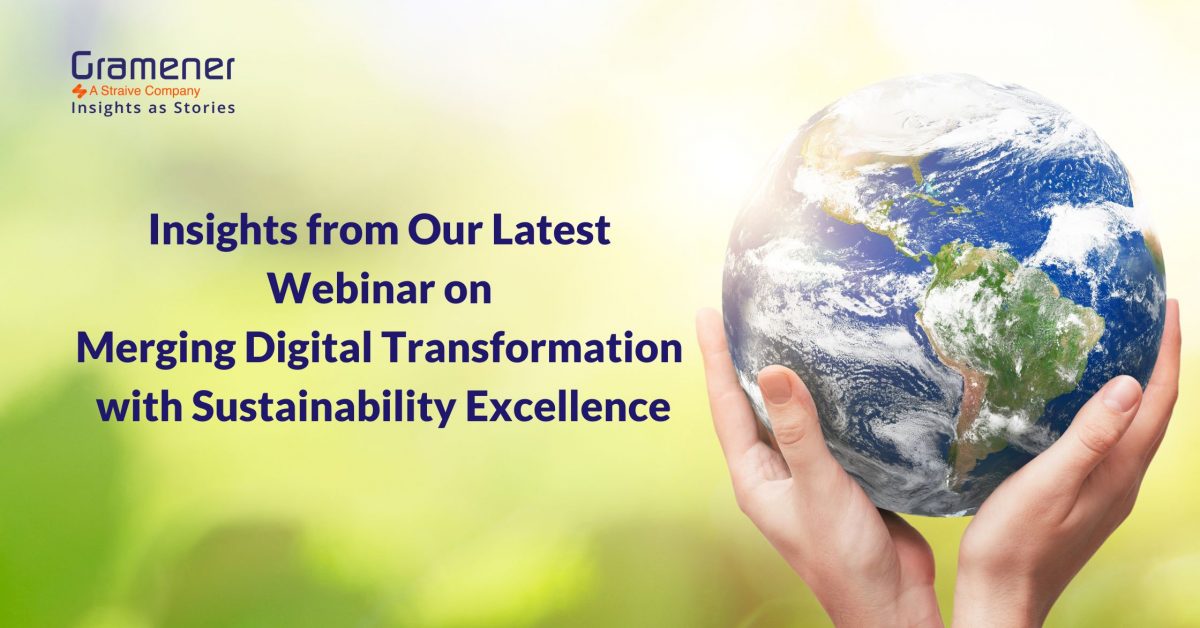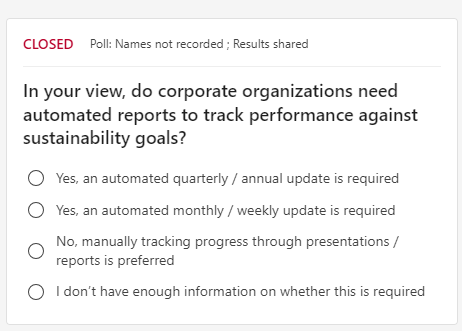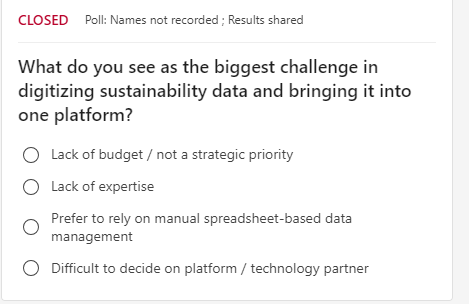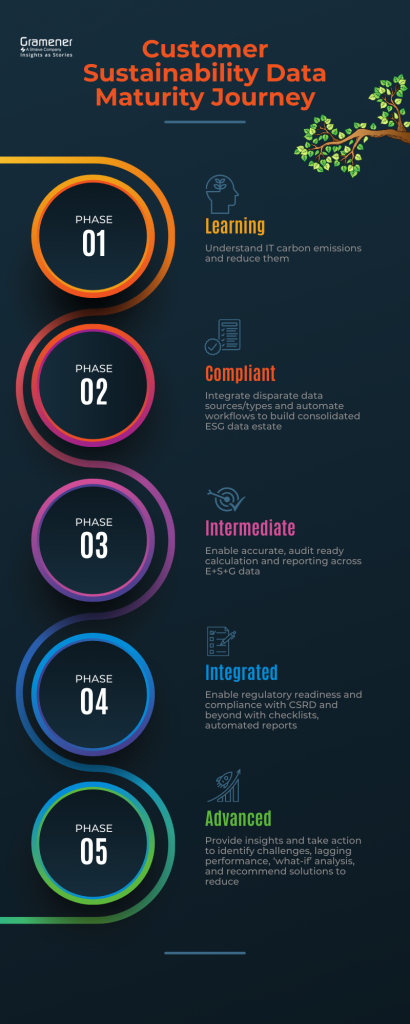On Leap Day, 29th February, we had a successful webinar on Merging Digital Transformation with Sustainability Excellence. Vijay Rangarajan, Global Black Belt (Partner) Microsoft Cloud for Sustainability, was the key speaker along with Aditya Bharadwaj, our Client Partner from ESG Tech, and Sundeep Reddy Mallu, our Head of ESG Tech & Analytics.

The webinar focused on how enterprises can approach sustainability, digital technology, and efficiency. It’s about starting with a foundational understanding and gradually increasing sustainability efforts.
Sundeep moderated the webinar, and Aditya started the discussion by highlighting the importance of Sustainable IT and CIO roles.
As a key speaker, Vijay talked about how adopting green IT practices and fostering a culture that values data-driven decision-making can drive sustainability. Over time, as sustainability matures, organizations can leverage digital technologies more effectively. It not only aids in transformation but also positions the organization as a market leader and differentiator, emphasizing the importance of evolving sustainability practices and digital integration.
Table of Contents
Strategic Roles Of CIOs In Sustainability
CIOs are pivotal figures in collaborating technology with sustainability initiatives. They are key drivers in aligning technology with sustainability, wielding their influence to bring change and foster collaboration across different business functions.
CIO leadership is crucial in these key areas: implementing Sustainable IT practices, like cloud migration and green procurement, to reduce environmental impact and harnessing IT for sustainability, where technology and analytics are used to optimize sustainability performance through tools like ESG data lakes and in-depth analysis reports.
Further, Aditya emphasized the positioning of CIOs and shared that they are at the intersection of technology and sustainability, so organizations can effectively pursue their environmental goals.
The dual approach of reducing the IT footprint while leveraging data for sustainability insights represents a holistic strategy towards more responsible and efficient business operations, ensuring CIOs and their teams play a pivotal role in the transformative journey towards a sustainable future.
Let’s see what statistics say about how Information and Communication Technology (ICT) is contributing to more carbon emissions!
Enterprise technology contributes to around 1% of global greenhouse gas (GHG) emissions, which is significant when considering the sector’s growing appetite for data and AI. This report emphasizes the importance of IT solutions in reducing this environmental impact, drawing attention to specific areas like data centers, cloud, and software, where emissions are particularly high.
The emissions impact of enterprise technology across various industries, showing a significant variation in how much each sector contributes to Scope 2 emissions. Industries such as insurance, banking, and communication are the top contributors, indicating a greater need for these sectors to adopt sustainable technology practices. This suggests that there is a potential for substantial positive change if these industries prioritize sustainability in their digital transformation strategies.
Aditya stressed the importance of monitoring and mitigating GHG emissions and shared that it’s the joint responsibility of the IT and Sustainability functions.
Cloud Migration & Virtualization
This strategy involves the estimation of baseline emissions from on-premises servers and their cloud equivalents, followed by the real-time monitoring of emissions. The goal is to identify and minimize the carbon footprint by shifting to more efficient cloud services and utilizing virtualization to reduce the number of physical servers required.
Sustainable Software Engineering
The focus here is on assessing and optimizing the carbon intensity of software operations. It encompasses training for developers on sustainable coding practices, using tools and standards designed to streamline code for energy efficiency, thus reducing the emissions generated during software use.
Green IT Procurement
This strategy highlights the importance of considering the embedded carbon-upstream emissions-in the procurement process. It advocates for incorporating the principles of the circular economy, which might include favoring products with lower environmental impacts and ensuring that the IT procurement process aligns with broader sustainability goals.
What Is Sustainable IT?
Sustainable IT practices encompass not only energy efficiency but also water conservation and e-waste management in data centers. On the water use front, data centers can adopt measures like Water Usage Effectiveness (WUE) monitoring and situating facilities in cooler climates to cut down on the water needed for cooling systems. Moreover, implementing targeted cooling strategies can further reduce water consumption.
In addressing e-waste, a staggering 53 million metric tons are generated, but only a fraction is recycled. Sustainable IT strategies must, therefore, include proactive maintenance to prolong device life, server disaggregation, optimizing equipment refresh cycles, and having structured decommissioning plans to ensure electronic waste is handled responsibly. These actions will contribute significantly to the reduction of e-waste, closing the loop in the IT lifecycle.
To understand the critical problems of the audience, we rolled out a poll:
- 57% agree that an automated quarterly or annual update is required.
- 33% think an automated monthly or weekly update is needed.
We launched another poll to understand the biggest challenge!
- 21% of the respondents feel that financial constraints or other strategic priorities limit their ability to adopt new data management solutions.
- The largest group, 36%, indicates that a deficiency in necessary skills or knowledge is a barrier to moving away from traditional data management systems.
- A smaller contingent, 15%, prefers to use manual spreadsheets for data management, possibly because they are familiar or perceived to be simple.
- 26% of the participants find selecting the appropriate platform or technology partner challenging, which is a critical step in transitioning to a more sophisticated data management system.
This poll hints at common issues that organizations encounter, which Gramener, through its partnership with Microsoft, can address by providing expertise, scalable solutions, and guidance in platform selection.
Further discussing IT for Sustainability, Aditya shared that AI Solutions can solve problems for ESG and Sustainability Teams.
AI can be a powerful tool in addressing the slow progress in sustainability efforts due to various bottlenecks. Its ability to measure, predict, and optimize complex systems is vital for overcoming challenges that are too intricate for traditional analysis. In addition, AI can expedite the development of new sustainability solutions, which are traditionally slow and expensive to create, and can also empower the sustainability workforce by bridging capacity gaps.
By leveraging AI, sustainability and ESG teams can accelerate their initiatives, making the implementation of sustainability solutions faster, more cost-effective, and superior in quality. AI’s potential lies in transforming sustainability from a concept into actionable practice, enhancing efforts towards achieving net-zero targets, nature-positive outcomes, and climate resilience.
Aditiya also shared the benefits of ESG Data Solutions:
- Meet regulatory reporting and compliance requirements
- Improve business efficiencies and reduce costs
- Meet stakeholder expectations
- Manage risk
- Create new business opportunities, including AI solutions
Customer Sustainability Data Maturity Journey
One of the most interesting key discussion points of this webinar was the sustainability data maturity journey. This journey can be segregated as per the following stages:
Adding to Aditya’s POV, Vijay Rangarajan from Microsoft talked about Microsoft’s dedicated cloud for sustainability.
Microsoft Cloud For Sustainability
Microsoft Cloud for Sustainability aims to empower various roles within an organization to manage their sustainability initiatives more effectively. For IT roles, it offers solutions like Emissions Impact Dashboards, Well-Architected Framework, and Green Software to manage IT emissions, Vijay continued.
Sustainability and finance professionals can benefit from tools like the Microsoft Sustainability Manager, while Microsoft Purview Compliance Manager helps with regulatory reporting. For environmental asset management, services like Environmental Credit Service are provided. These solutions are interconnected through the Microsoft Cloud for Sustainability data model and are built on the foundational Microsoft Cloud platform. They are designed to transform disparate ESG (Environmental, Social, Governance) data into actionable insights and standardize processes for managing environmental assets across their lifecycle.
Further, Vijay explained the magical power of automating sustainability data ingestion, processing, and reporting explicitly.
Microsoft Cloud for Sustainability is a robust platform designed to streamline sustainability data management across an organization. It integrates operations and value chain data into the Microsoft sustainability manager, providing data capture, calculation, reporting, and goal-tracking tools. These capabilities are enhanced by ESG data intelligence, which leverages advanced analytics and AI modeling, and ESG data estate, which focuses on data aggregation and standardization.
The platform facilitates reporting to internal teams, supply chain partners, and external bodies, supporting actionable insights that drive reduction initiatives and progress toward sustainability goals. The Microsoft Purview Compliance Manager, with CSR reporting templates and upcoming additions, connects all these functionalities, embodying a cohesive system for automating sustainability efforts from data collection to compliance and action.
Well, after explaining the power of Microsoft Cloud for Sustainability, Vijay shared a holistic overview on:
How Should Organizations Approach Sustainability, Digital & AI Maturity?
A strategic framework for organizations involves addressing sustainability concurrently with digital and AI maturity advancements. Let’s categorize organizations into those that outperform, aligning high sustainability maturity with digital and AI leadership, and those that underperform with low sustainability practices despite AI advancements.
It’s essential to align corporate strategies with sustainable practices and digital innovation, suggesting that leading companies integrate a Digital & AI Feedback Loop that enhances sustainable products, operations, workforce, customer relations, and compliance, powered by data intelligence and a focus on reducing carbon, water, waste, and ecosystem impacts.
Leverage Microsoft Cloud For Sustainability
Businesses seeking to enhance their sustainability measures can leverage the collaboration between Gramener and Microsoft to use Microsoft Cloud for Sustainability.
Through this partnership, Gramener will combine its data science and AI expertise with Microsoft Azure’s advanced analytics and cloud services.
You can benefit from the seamless integration of sustainability data, harness powerful tools for reporting, analyzing, and reducing environmental impact, and ensuring compliance with evolving regulations.
This integration allows for efficient tracking of carbon footprints, water usage, and waste management, enabling businesses to make data-driven decisions that align with their sustainability goals and public commitments.
Let’s book a discovery call!




